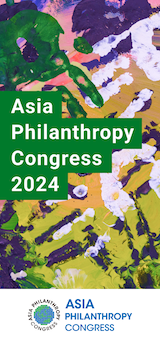Jewish philanthropy has an illustrious history of stepping up in times of crisis and achieving impressive feats. Its response to events on October 7th when Hamas attacked communities and military bases in southern Israel killing 1,200 people was no different.
The crisis unleashed by this attack was multifaceted, involving urgent and long-term needs in Israel and an explosion of antisemitism around the world.
The first challenge was to provide rapid and urgent assistance immediately after the massacre. At that time, the Israeli government was in disarray and its response to the crisis was either dysfunctional or non-existent. Israeli civil society, supported by philanthropy, filled the leadership vacuum, providing vital services identifying the dead and kidnapped and assisting hundreds of thousands of evacuees from the North and South of the country.
Funders provided support to expand the capacity of nonprofits dramatically, like the trauma organization NATAL, which multiplied its caseload by orders of magnitude. They helped nonprofits repurpose – like the international aid agency IsraAID, which deployed its skills within Israel for the first time.
Funders reacted quickly to address the possibility of tension and violence between Jewish and Arab citizens of Israel. In this area, the contribution of philanthropy and civic leadership was critical. Not only did an explosion within Israel not happen, but Arab levels of identification with the state and their Jewish neighbours saw record highs.
It’s important to note that the mobilization of philanthropy paled in comparison to the way in which regular Israelis mobilized after the massacre. Studies estimate that nearly half of all Israelis volunteered in the first weeks of the war. That doesn’t count the unprecedented response to the army reserve call-up (Israel has a popular army that consists mostly of civilian reservists).
Connected to that unprecedented mobilization, there were many grassroots and civil society efforts to provide support to those affected by the crisis. At times, funders found it challenging to assess the effectiveness of these initiatives. As a result, established ‘legacy’ organizations ended up receiving the majority of the funding.
It became evident very quickly that this crisis would be a long one, so funders learned to pace themselves. Vast resources — physical, economic, and emotional — would be needed for the reconstruction effort. It was also apparent that the relationship between Jewish funders and the Israeli government would remain fraught. For example, Tekuma, a governmental authority created to fund and organize the reconstruction of the communities of the ‘Gaza Envelope’ – the area comprising Israeli communities near the Gaza strip – has had several changes in leadership. Despite having a decent budget, it’s unclear what the scope of its work will be. There’s no similar government structure for the North, which demands even more philanthropic leadership and funding.
It’s still difficult to estimate accurately the scale of philanthropy from the Jewish diaspora to Israel. Based on informal surveys of our members at the Jewish Funders Network and knowledge of the field, we estimate that the amount of philanthropic dollars going to Israel has doubled – representing an extra $2 billion.
The system of Jewish Federations of North America – city-based fundraising and community funding bodies – has collectively raised and contributed approximately $1 billion. Private funders have given a similar amount. And it’s estimated that $1 billion has been donated by Israeli funders.
Many Jewish funders also seek to support the needs of Palestinian civilians in Gaza. However, it became evident very quickly that the main issue in terms of humanitarian support in Gaza is not one of funding, which seems to be abundant, but one of distribution. Funders in our network report finding it difficult to ensure that aid won’t be sequestered by Hamas rather than be distributed effectively to those in need.
At the same time, the war has triggered the worst wave of antisemitism since the Second World War. Even before Israel responded to the massacre, we saw demonstrations, which many in our community viewed as anti-Jewish. These included chants of ‘resistance is justified when Palestine is occupied’ which many of our community experienced as expressing support for Hamas and the murders on October 7th.
In the US, antisemitic acts have increased by 140 percent. They have doubled in the UK and tripled in France. Victims who speak out are accused of ‘weaponizing antisemitism.’ The bulk of antisemitic incidents in this wave come from the progressive left and intellectual elites not from the traditional far-right sources. Its most visible manifestations have been at university campuses, but Jews face discrimination and harassment in every ‘progressive’ space.
The rise of antisemitism has three direct effects on Jewish philanthropy.
First, there are urgent needs in terms of the safety of Jewish organisations, which are routinely vandalized and attacked. In the US, the costs of securing Hillels on campus (university Jewish clubs) is $35 million. Much comes from Jewish philanthropy.
Second, many Jewish funders feel betrayed and abandoned by grantees they’ve been supporting for decades – from universities, arts organisations, and even climate movement organisations. Funders active in these spaces saw with dismay, among other things, Greta Thunberg leading a protest in Malmo, Sweden, against the appearance of an Israeli singer at the Eurovision song contest. Many, understandably, have ceased funding those organizations, and a realignment of philanthropic priorities is now underway.
Third, the dramatic increase in antisemitism has created a phenomenon that we call ‘the surge.’ Jews are flocking back to Jewish community organisations having felt threatened and abandoned outside. Many are returning to religious practice and engaging in Jewish learning and communal activities. This requires funding for organisations to meet the increased capacity needs.
In sum, the philanthropic response has been generous, as strategic as possible, and enduring. There’s a feeling among funders that the proverbial ‘rainy day’ has arrived, and that we’ll be judged by history on how we support the Jewish People and Israel in its most difficult moment in two generations.
As I said in my speech at the Jewish Funders Network conference in Tel Aviv earlier this year: ‘Every generation of Jews has a challenge that defines them; a trial that defines how history will judge us. Two generations ago, it was the Holocaust and the creation of the State of Israel. A generation ago, it was the Yom Kippur War and the liberation of Soviet Jewry. For us, this is it. This is our challenge.’
Andres Spokoiny is the CEO of the Jewish Funders Network, an international community of Jewish philanthropists and foundations.
This article was published as a part of a series of pieces exploring Jewish and Israeli philanthropy’s response to October 7. Read the series here.






Comments (0)